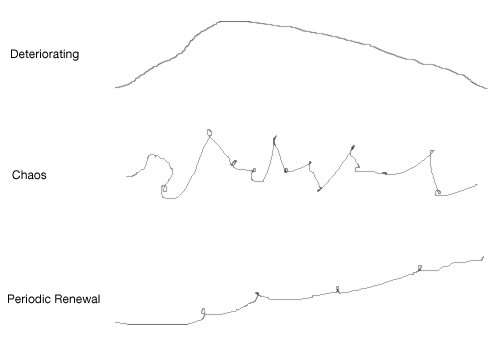There’s a funny (or cruel, depending) dilemma to improving your work over time. If you don’t do it, your organization becomes less and less valuable over time, gradually failing, and dying an unfortunate death. If you do all the time, you never get to benefit from each change very long and probably suffer from change fatigue. We’ve even labeled these positions in our worldviews: conservatives want to keep things just the way they are – thank you very much – and progressives always want to embrace the something better that’s just around the corner.
My fix for this is simple: Instead of never changing or constantly changing, set a regular period when you revisit your process. And just so you’re pretty sure the change is leading to improvement, have a simple way to keep track of what you did, why, and what happened as result. Not every change will result in improvement, but at least you’ll know that and not repeat your mistakes.
We can look at this in evolutionary terms using the example of sharks. A shark doesn’t evolve constantly, it evolves by having baby sharks (which are amusingly called pups) that have unique DNA that make them more or less successful than their parents. While each shark is alive, her life is a time of trying out her DNA and either succeeding or failing to have her own pups. Reproduction is a time of trying slight variations (aka gene mutation) on what worked before and only passing on the DNA of successful sharks. Over time, sharks become more and more successful at being sharks.
I’ve started developing a simple model of the nature and frequency of process change in companies based on what I’ve seen in the dozens of companies I’ve worked for or with. The model boils it down to three types:
- Deteriorating: When the company was young they designed and established productive methods, but over time the methods gradually lose value as the environment changes. We see this trend in the Management Practices across Firms & Nations survey.
- Chaos: Change is constant, usually reactionary, and there’s little history of past changes to help judge the effectiveness of future changes.
- Periodic Renewal: The company designs and establishes some methods and measures the results, periodically revisiting them and making improvements.
I might draw them like this:

And I might track the change over time like this:
(diagram coming soon)
Periodic renewal requires the organizational discipline to stick with what works as well as the resolve to occasionally improve it, a careful balance. For many companies, the closest analog is periodic performance reviews. We don’t formally judge our colleague’s performance and award raises every day, we do it periodically (or suffer the wrath of seriously pissed off colleagues). How good is your performance review process? Judging your ability to improve this process over successive versions may indicate your current ability to institute periodic renewal of other processes.